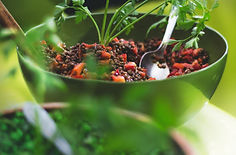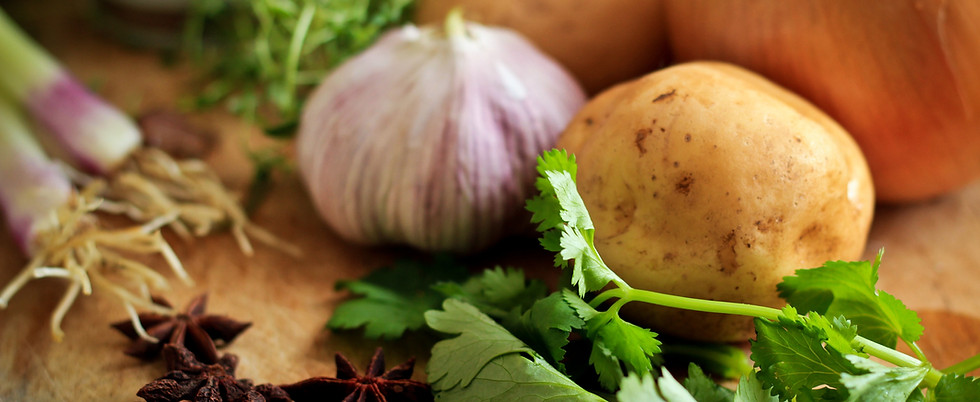
Healing with AYURVEDIC NUTRITION
Food as Fuel and Medicine
Although, as a species, we will have always enjoyed eating, once upon a time (when food was more scarce) eating was an
activity we engaged in primarily as a means of fuelling the body and, through foods naturally therapeutic and
mind-body balancing effects, bringing relief to uncomfortable symptoms.
For many centuries, our meals/ingredients were:
-
cooked from fresh (often straight out of the ground!)
-
grown locally to a town or region
-
farmed organically with no chemical or pesticide use
-
available only in specific seasons
-
eaten according to folklore (as benefiting specific people with
specific conditions) -
consumed to fuel a heavy working day
-
taken in smaller portions
-
consumed with little to no processing
-
taken without preservatives, additives, chemicals and carcinogens

Old to New - Our loss of Wisdom around Eating
Old to New - Our loss of Wisdom around Eating
New world: new food
With the the advent of industrialisation and the ability to mass produce foods - in unprecedented quantities, more cheaply and out of season - we are now able eat for many more reasons than fuel. We eat to be social,for comfort, to pursue fitness or just for fun! With ready-made food available in every form at almost any hour, day or night, we can eat pretty much whatever we want, whenever we want.
Although all of these diverse, interesting and delicious options make getting fuel an easier and more enjoyable process, eating this way leaves our digestion confused, sluggish and slow and our energy levels on the floor.




Modern "foods" typically:
-
are not native to our own environment and may not be suitable to be
-
eaten in a different climate
-
are available outside of season, often flown in from overseas
-
would ancestors/our eatena cuisine which we have never form part of
-
never have eaten and may not suit our inherited digestive systems
-
are high in processed sugar, saturated fats, salt, preservatives, pesticides
-
and additives
-
are old, stale, processed, canned, frozen, repeatedly cooked and/or
-
microwaved (quite 'dead')
-
possess qualities which do not balance our unique composition
-
of tridosha
-
are consumed at the wrong time of day and in combination with
-
incompatible foods
On top of this we are bombarded with information about nutrition
'dos and dont's' (which always change) and leave us thoroughly
confused about what to eat. This often means that the foods we end up
eating are the ones we 'think' we need, what science says is good right
now or what's in trend, rather than what we really need.
As the times change so do our diet and lifestyles and times are changing quickly! Sadly, our mind and bodies haven't caught up.
The negative impacts of new ways of living and eating are widespread, deep-seated and affect our whole being including:
-
a loss of our innate wisdom about food and a sense of what
-
food is beneficial to us uniquely
-
a loss of our mind-body connection to nature and our environment
-
de-stabilisation of the tridosha (and development of a vikruti)
-
damage to the digestive fire (agni) and development of toxins (ama)
-
increased anxiety, stress, depression or dependence on foods
-
(such as anorexia or sugar addiction)
-
proneness to acute or chronic digestive discomfort or disease
-
(gas, bloating, constipation, diarrhoea, IBS, Crohns, Ulcerative
-
Colitis, gastric ulcers etc)
-
food sensitivities
-
reduced nutrient digestion and assimilation leading to malnutrition
-
development of chronic inflammatory conditions
-
reduced/overactive immune functioning
-
the onset or aggravation of other health conditions
Agni and Ama: The Root of all Ease and Disease
Agni and Ama: the root of all ease and dis-ease
Ayurveda argues that all health and disease begins with digestion - we literally are what we eat. Proper functioning of the digestion and our ability to extract nutrients of food is fundamental to health, well-being and happiness. In Ayurveda, the digestive/metabolic strength, regularity and capacity are jointly known as Agni (also the name of the Hindu god of fire).
When Agni is functioning well you have:
-
Adequate appetite (hunger every 3-6 hours depending
on size of previous meal) -
Timely evacuation of good quality bowel motion (1-2 times a day)
-
Feeling of lightness and physical strength
-
Good resistance to infection
-
Healthy skin colour, texture and lustre
-
Proper functioning of the sensory organs (particularly taste
and smell)
Charaka Samhita Chikitsa Sthana 15/8-9
When the agni is compromised (typically when there is vikruti) digestion is impaired; the guts ability to extract nutrition from food is hampered, the body has very few quality 'building blocks' in which to create strong healthy tissues and immune system and production of hormones are affected.
Symptoms of improper digestion include:
-
Gas and bloating
-
Abdominal pain and discomfort
-
Heartburn
-
Lack of/excessive hunger
-
Nausea
When impaired digestion continues over a longer period of time, food particles (which remain undigested due to weakened agni) begin to stagnate in the gut creating a sticky tar like substance know as Ama. Development of Ama further augments the weakness in digestion, blocks the channels of the body and increases risk of inflammation. Ultimately, the bodies ability to detoxify and purge unwanted materials is diminished and eventually leads to disease (typically autuo-immune disease).
Symptom of Ama include:
-
Loss of appetite
-
Tiredness, exhaustion and sleepiness
-
Constipation and sticky stools
-
Sneezing and stuffy nose
-
Weakness and feelings of heaviness of the body
-
Apathy, disinterest and depression
-
Body and muscles aches and pains
-
White coating on the tongue
-
Functions of Vata are diminished (energy levels,
thinking, talking, pulse)




Think about what you ate today. Why did you eat this specifically?
How did you feel afterwards?
Restoring digestive bliss: Ayurvedic eating for health and well-being
If all ill-health begins with digestion, so is it true that all healing begins from the inside out, starting with the gut. The secret to restoring digestive and metabolic harmony is to follow that which rejoins body and mind to the lost inner wisdom about food. Translation, its about finding those good old fashioned 'gut feelings'again. The secret to get the ball rolling, Ayurveda guides, is to ensure that the inner (doshic) and outer (diet and lifestyle) environments, and their qualities, are in harmony. This means, as often as possible, only consuming foods which suit our constitution, season, place, age and time and, where possible, eating food which is fresh unprocessed and as close to its source as possible.
Restoring Digestive BLiss with AyurvedA




Ayurvedic eating: Food qualities
As we discussed in About You, all living things have a unique constitution and the (previously living and breathing) food we eat is no exception. Every ingredient we throw into our meals has a unique composition of elements which gives food its unique taste, macro/micro classification, chemical composition, quality and, most importantly, their effects once inside the body.
How you work out your foods 'doshic constitution’ is a little different to the way you measure dosha (as the qualities are more subtle) but, as you can guess, this is most easily done through taste. Though we do have some other ways too.
In Ayurveda, food is classified by:
-
Rasa – Taste (either sweet, sour, salt, pungent, bitter or astringent)
-
Guna – Quality (heavy, light etc)
-
Virya – Potency (hot or cold)
-
Vipaka – post digestive effect (Sweet, sour, bitter)
Ayurvedic eating: Dosha
Ayurveda works through a ‘like increases like’ and ‘opposites reduce’ principle. This means that if you are, for example, a kapha (earth and water) predominant individual, consumption of foods high in earth and water (such as dairy and wheat) will increase your innate kapha, causing uncomfortable symptoms such as excessive weight gain, sticky constipation, congestion and AMA symptoms. On the other hand, if you eat foods that are higher in air and space (vata dominant) such as lentils, puffed rice and green vegetables, this will reduce kapha, encourage weight loss and help you to feel lighter, fresher and more energised.
But how to know what foods affect which dosha?
-
Sweet, sour and salty foods all contain more earth + water elements – these increase kapha
-
Sour, salty and pungent foods all contain more fire + water – these increase pitta
-
Bitter and astringent foods all contain more fire + water – these increase vata
Comprehensive food guidance for the Tridosha can be found at Banyan Botanicals:
For Vata types - https://www.banyanbotanicals.com/info/ayurvedic-living/living-ayurveda/diet/vata-pacifying-diet/
For Pitta types – https://www.banyanbotanicals.com/info/ayurvedic-living/living-ayurveda/diet/pitta-pacifying-diet/
For Kapha types - https://www.banyanbotanicals.com/info/ayurvedic-living/living-ayurveda/diet/kapha-pacifying-diet/
It is important to remember that although Ayurveda provides a lot of guidance, it is only that - guidance and should never be the only rationale for choosing food – above all it is important to follow your gut!
Ayurvedic eating: Season
In the same way that our food has unique qualities (hot/cold, dry/moist etc)
which affect our dosha, so does our external environment. We all know
that the nature of our surroundings can change dramatically depending
on season (or by the hour if you live in the UK!). Yet we seem to have
forgotten that paying attention to the changing environmental qualities, and
choosing food accordingly, is crucial in maintaining health i.e a healthy
balance of dosha and strong agni.
Here is an example of where you might go wrong:
If a kapha dominant person (perhaps with kapha vikriti) were to eat kapha
increasing food (ice cream etc) in winter, the end result would be kapha increase/
overflow causing congestion, dull stomach ache, weight gain, nausea and
heaviness due to increase in cold and moisture which overwhelms the body.
Ayurveda instead recommends you favour foods with qualities opposite to the
season i.e ginger, garlic and dry lentils in winter.

To meat or not to meat
In Ayurveda we often rave about the benefits of lentils and pulses, but Ayurvedic eating does not always mean veggie – this is a common misconception. As lentils and pulses are light in nature and easy to digest (when soaked and cooked with oils and digestive spices) and suit most digestion types, they form a key part of the Ayurvedic diet. That said, high quality, properly cooked meat has its place in Ayurveda. Being heavy, oily and grounding, meat it is extremely beneficial in moderate quantities for vata dominant individuals, in vata specific vikriti and in Autumn (vata season).



Food combining and incompatibility
The concept of food compatibility (that certain foods do/do not digest well together) is often quite new to people - despite being a fundamental element of Ayurvedic eating for thousands of years.
Sadly, examples of incompatible food combinations are literally everywhere. Often promoted as the trendiest health/weight loss foods, the nations favourites 'bad mixes' line the shelves of supermarkets and dominate our favourite magazine recipes, TV adverts and cooking shows. Why? Because they taste, look and sound oooh so good. Sadly, they are the likely culprit for those IBS toilet trips or the most unwelcome the mid-afternoon bloat - urgh!
The most common examples include:
-
fruit and dairy (who doesn’t love berries and yogurt or a lush fruit smoothie)
-
meat and dairy (we all knew cheese burgers are too good to be true)
-
beans and dairy (cheesy Mexican food anyone?)
-
mixed fruit (a fruit salad is always a healthy option though right!)
-
fish and dairy (but I can't live with a good old fish pie or tuna mayo)
-
fruit and grains (nooo, my berry porridge!)
Unfortunately, mixing foods with different energetic and digestive
qualities can create serious havoc for digestion resulting in:
-
poor or painful digestion
-
increased, reduced or painful elimination
-
fermentation, bloating, gas
-
development of Ama symptoms
Its not to say you have to do a complete overhaul of your diet over night but if you are suffering from any kind of gastric distress, and ESPECIALLY if you are taking medication for symptoms such antacids/IBS etc it is strongly advised that you begin applying small changes as soon as you can. More conscientious selection and combination of foods can greatly improve digestive health and over all wellbeing (it can't hurt to use coconut yoghurt instead right?).
Satmya - good habits
If your'e thinking "well there goes my entire diet" - don't fret. There are a couple of exceptions to the rule. If, like me, you have been eating certain food combinations your entire life (like fruit and cheese or tuna mayo) with no impact your agni is likely to have adapted, this is known as Satmya. This means you won't get the usual disturbances that someone who later adds this to their diet might face.
But it is important to remember to revisit these guidelines if you feel your digestion is suffering as removing a few combos will boost your healing process.
My Ayurvedic plate
For optimum agni functioning and maintenance of the dosha
your food should (as often as possible and most certainly
when under the weather) be:
-
taken in a portion no bigger than your two hands
cupped together or until comfortably full (not stuffed!) -
warm, slightly liquid and soft (rock hard, dense or really dry
foods can cause bloating) -
contain appropriate spices for constitution to aid digestion
-
having qualities suited to your dosha to balance to prakriti and virkiti
-
be taken in accordance with season (if its cold outside, avoid
cold food!) -
contain correct food combinations (avoiding the above incompatible
mixture of ingredients) -
contains all 6 tastes in proportions which are beneficial to
prakriti/vikriti (this will help you feel satiated so you aren't
hunting for dessert) -
only taken when properly hungry (at least 3-4 hours after the
previous meal) -
taken with small sips of warm water (cold water causes gas,
poor processing and too much water reduces concentration of
digestive enzymes) -
is 50% vegetables with 25% protein and 25% carbohydrates
(as a rule, varies in certain disorders however)

Just one step at a timE ......
It is easy to feel overwhelmed by what seems like a lot of ‘rules’ but again, Ayurveda offers up these concepts to help build up a bigger
picture of the self and our relationship with our environment and our nourishment.
The key is to incorporate changes slowly, one thing at a time and if you need advice, guidance and support I am always here to help! Happy Ayurvedic Eating!
Lets get you started with our Recipe Library

